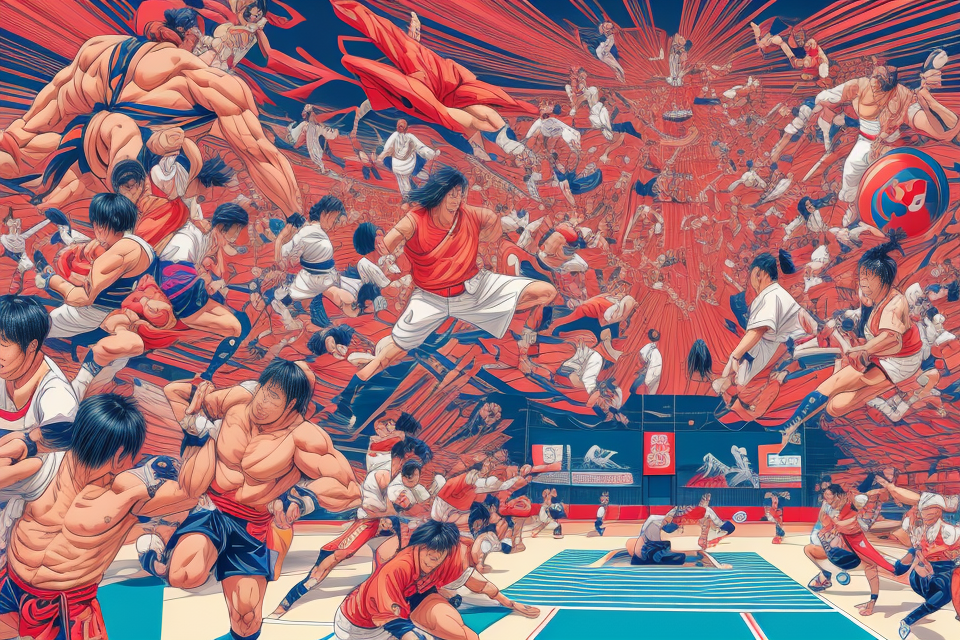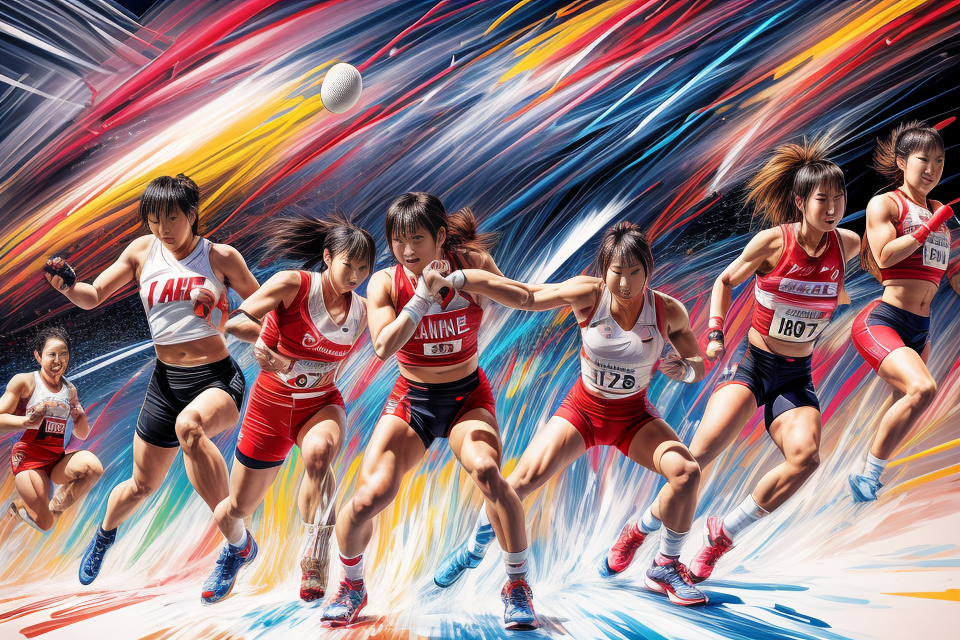Japan is a country that has made a significant impact on the world of sports. Known for its passionate fans and top-level athletes, Japan has a rich history in various sports, including baseball, football, tennis, golf, and sumo wrestling. Japan’s success in sports is a testament to the country’s dedication to hard work, discipline, and teamwork. With its unique culture and tradition, Japan has been able to showcase its skills and talent in various sports, making it a force to be reckoned with in the international sports community. So, let’s dive into the world of Japanese sports and explore what makes this country so successful in the realm of athletics.
Japan has a rich and diverse sports culture, with many sports in which the country excels. Perhaps the most well-known is sumo wrestling, a traditional Japanese sport that involves two wrestlers competing in a circular ring. Japan also has a strong tradition in martial arts, with disciplines such as judo, karate, and kendo being popular both domestically and internationally. In addition, Japan has had success in sports such as baseball, football (soccer), and golf, with many Japanese athletes competing at the highest levels of these sports around the world. Overall, Japan’s sporting success is a testament to the dedication and hard work of its athletes, as well as the country’s strong sporting infrastructure and culture.
Sports Culture in Japan
Popularity of Sports in Japan
- Japan’s passion for sports:
- A nationwide obsession with baseball, soccer, and other sports
- Emphasis on teamwork and fair play
- Widespread participation in sports at all levels, from professional to recreational
- Japan’s national sports participation rate:
- One of the highest in the world, with over 80% of the population regularly engaging in sports activities
- Encouraged by government initiatives promoting physical fitness and health
- Sports played both individually and as a team, reflecting Japanese culture’s emphasis on social connections and community involvement
Impact of Sports on Japanese Society
- Role of sports in promoting a healthy lifestyle:
- Sports as a means to maintain physical fitness and combat the aging population’s health issues
- Widespread access to sports facilities and programs for people of all ages and abilities
- Integration of sports into school curricula, fostering lifelong participation and interest
- Sports as a unifying force in society:
- Providing opportunities for social interaction and community building
- Encouraging teamwork, discipline, and resilience among participants
- Serving as a platform for international exchange and friendship through international competitions and events
- Economic impact of sports in Japan:
- Sports industry contributing significantly to the country’s GDP
- Attracting foreign tourists and investment through major international sporting events, such as the Tokyo Olympics
- Creation of employment opportunities in areas such as sports equipment manufacturing, event management, and sports-related services
Baseball: Japan’s National Sport
History of Baseball in Japan
- Origins of baseball in Japan
- The introduction of baseball to Japan in the late 19th century by American sailors and missionaries
- The establishment of the first baseball club in Japan in 1878
- The spread of baseball throughout Japan in the early 20th century
- Growth of baseball as a popular sport
- The formation of the Japanese Baseball League in 1936
- The rise of Japanese professional baseball teams in the post-World War II era
- The development of baseball academies and training programs for young players
Professional Baseball in Japan
- Nippon Professional Baseball (NPB)
- The establishment of NPB in 1936
- The current structure of NPB, which consists of two leagues (Central and Pacific) with six teams each
- The importance of NPB in Japanese culture and society
- Top teams and players
- The most successful teams in NPB history, including the Yomiuri Giants and the Hanshin Tigers
- The most talented players in NPB, such as Shohei Ohtani and Ichiro Suzuki
- Popularity of baseball in Japan
- The widespread popularity of baseball in Japan, with millions of fans following the sport
- The economic impact of baseball in Japan, with teams generating significant revenue and attracting large crowds to games
- The cultural significance of baseball in Japan, with the sport playing a central role in the country’s national identity and sense of pride.
Sumo: Traditional Wrestling in Modern Japan
Sumo is a traditional Japanese wrestling sport that has evolved over time to become a modern sport with its own set of rules and regulations. The sport has a rich history that dates back to ancient times, and it continues to be a popular spectator sport in Japan today.
History of Sumo in Japan
Sumo has its origins in ancient Japan, where it was initially used as a form of entertainment during festivals and religious ceremonies. The sport was also used as a way to settle disputes between rival clans and to demonstrate the strength and courage of samurai warriors. Over time, sumo evolved into a more organized sport, with rules and regulations being established in the Edo period (1603-1868).
During this time, sumo matches were held in special arenas called “sumo stables,” and the wrestlers were often members of the samurai class. The sport continued to grow in popularity, and in the modern era, sumo has become a professional sport with its own league and rules.
Sumo Tournaments and Rituals
Sumo tournaments are held throughout the year, with the biggest and most prestigious tournaments taking place in Tokyo’s Ryogoku district. There are six major tournaments, known as the “big six,” which are held in Tokyo, Nagoya, Osaka, and Fukuoka. These tournaments attract large crowds of spectators and are broadcast on television throughout Japan.
In addition to the tournaments, there are also various rituals and traditions surrounding sumo. For example, before each match, the wrestlers perform a ceremonial dance called the “dohyo-iri,” where they circle the ring while shouting and waving a small flag. Another tradition is the “mawashi,” or the “dance” that the wrestlers perform after winning a match.
Sumo wrestlers are also known for their unique dress, which includes a loincloth called a “mawashi” and a belt called a “hara.” The wrestlers must weigh in before each tournament, and those who fail to make weight are disqualified. The matches themselves are intense and physical, with wrestlers using a variety of techniques to try to throw their opponents out of the ring.
Overall, sumo is a unique and fascinating sport that has a rich history and tradition in Japan. It continues to be a popular spectator sport, with fans and spectators from all over the world coming to watch the tournaments and experience the excitement of sumo wrestling.
Japanese Martial Arts: From Karate to Judo
Origins of Japanese Martial Arts
Japanese martial arts, also known as Budō, have a long and rich history dating back to the ancient times. The earliest known examples of Japanese martial arts can be traced back to the Kofun period (250-538 AD), where archaeological evidence has been found of weapons such as swords and spears being used in combat. During the Nara period (710-794 AD), martial arts were developed for military purposes and were used by the samurai class.
As time passed, various martial arts styles developed, each with its own unique techniques and philosophies. Some of the most well-known styles include Kendo (Japanese fencing), Judo (a grappling martial art), and Karate (a striking martial art).
Popularity and Influence of Japanese Martial Arts
Karate is one of the most widely practiced martial arts in the world, with millions of practitioners globally. It originated in Okinawa, an island south of Japan, and was developed as a way for people to defend themselves without weapons. The style emphasizes striking techniques such as punches, kicks, and knee strikes, and also includes grappling and throwing techniques.
Judo, on the other hand, was developed in the late 19th century by Jigoro Kano. It is a grappling martial art that emphasizes throwing and pinning techniques, as well as ground fighting. Judo has become popular all over the world and is an Olympic sport.
Other popular martial arts in Japan include Aikido, which emphasizes blending with an opponent’s movements and using their energy against them, and Iaido, which is the art of drawing and cutting with a sword.
In conclusion, Japanese martial arts have a long and rich history and have played an important role in Japanese culture. From Karate to Judo, these martial arts have gained popularity and influence all over the world, and continue to be practiced and respected as important aspects of Japanese culture.
Cycling: A Popular Sport for All Ages
Popularity of Cycling in Japan
Cycling is a popular sport in Japan, with both road cycling and mountain biking gaining popularity among individuals of all ages. In addition to leisurely rides, cycling events and races are also common, with many professional cyclists coming from Japan.
Cycling Infrastructure and Culture
Japan has a strong cycling culture, with many cities and roads being designed with cycling in mind. Bicycles are a common mode of transportation, and many people use them to commute to work or school. In addition, there are many cycling-related businesses and organizations in Japan, such as bike shops and cycling clubs, which contribute to the growth and development of the sport.
Basketball: On the Rise in Japan
Growth of Basketball in Japan
Basketball has experienced a significant increase in popularity in Japan over the past few decades. This surge in interest can be attributed to various factors, including the success of Japanese basketball players in the NBA and the growing influence of the league in Japan. The NBA has played a crucial role in promoting the sport and inspiring a new generation of basketball players in the country.
Professional Basketball in Japan
The professional basketball scene in Japan is dominated by the B.League, which was established in 2016. The league comprises 36 teams, divided into two divisions, and operates under a system of promotion and relegation. The top teams in the B.League include the Tokyo Metropolis-based Chiba Jets, the Akita Northern Happinets, and the Niigata Albirex BB. These teams have consistently performed well and have a strong following among basketball fans in Japan.
In addition to the B.League, there are several other professional basketball leagues in Japan, such as the National Basketball League (NBL) and the Women’s Japan Basketball League (WJBL). These leagues provide opportunities for talented players to showcase their skills and compete at a high level.
Basketball facilities and infrastructure in Japan have also improved significantly in recent years. The country boasts several world-class arenas, such as the Saitama Super Arena and the Toyota Center, which host international tournaments and events. These facilities have contributed to the growth of basketball in Japan and have helped to attract more fans to the sport.
Overall, basketball is on the rise in Japan, and the country’s success in international competitions, combined with the popularity of the NBA, has helped to fuel this growth. The future of basketball in Japan looks bright, with many talented players and dedicated fans supporting the sport.
Tennis: Japan’s Rising Tennis Stars
Tennis in Japan
Tennis has a rich history in Japan, dating back to the late 19th century when the first tennis club was established in Yokohama. However, it wasn’t until the 1920s that tennis began to gain popularity in the country, thanks in part to the efforts of Japanese tennis pioneers such as Jiro Sato and Shu Kudura.
Over the years, tennis has continued to grow in popularity in Japan, with the establishment of the Japan Tennis Association in 1923 and the country’s first Davis Cup victory in 1927. Today, tennis is one of the most popular sports in Japan, with numerous tennis courts and clubs throughout the country.
Japanese Tennis Players Making Waves Internationally
In recent years, Japan has produced several tennis players who have made a splash on the international stage. Perhaps the most well-known of these players is Naomi Osaka, who won her first Grand Slam title at the 2018 US Open and has since gone on to win multiple other titles, including the 2019 Australian Open and the 2021 French Open.
Another prominent Japanese tennis player is Kei Nishikori, who became the first male Japanese player to reach the top 10 in the ATP rankings in 2012. Nishikori has since established himself as one of the top players in the world, with a career-high ranking of world No. 4 in 2017.
In addition to Osaka and Nishikori, there are several other promising Japanese tennis players who are making waves on the international stage. These include players such as Yoshihito Nishioka, Taro Daniel, and Miomir Kecmanovic, who have all achieved significant success in their careers and are poised to become major forces in the sport in the years to come.
Sports Education and Development in Japan
Sports Education in Schools
Japan places great emphasis on sports education in its schools, recognizing the importance of physical activity in promoting overall health and well-being. Physical education programs are mandatory and integrated into the curriculum, with students participating in regular classes and activities throughout their academic careers. In addition to formal physical education classes, many schools also offer extracurricular sports activities, such as club sports and athletic teams, providing students with opportunities to develop their skills and interests in a variety of sports.
Sports Development Programs for Youth
Japan has a strong tradition of youth sports, with many leagues and organizations dedicated to promoting and developing sports participation among children and adolescents. These programs provide young athletes with access to trained coaches, quality facilities, and competitive opportunities, helping them to develop their skills and pursue their passion for sports. In addition to organized leagues and teams, sports camps and clinics are also popular, offering intensive training and instruction in a variety of sports. For elite athletes, scholarships and other opportunities are available to help support their athletic pursuits and advance their careers.
FAQs
1. What sports are popular in Japan?
Japan is known for its love of sports, and many sports are popular in the country. Some of the most popular sports in Japan include baseball, football (soccer), basketball, sumo wrestling, martial arts such as judo and karate, and golf. Additionally, Japan is famous for its traditional sports, such as kendo (sword fighting), archery, and horse racing.
2. Is Japan good at winter sports?
Yes, Japan is very good at winter sports. The country has hosted the Winter Olympics twice, in 1972 and 1998, and has won numerous medals in sports such as figure skating, short track speed skating, and ski jumping. Japanese athletes have also been successful in sports such as snowboarding and alpine skiing.
3. What is Japan’s national sport?
Japan does not have an official national sport, but baseball is often considered to be the country’s most popular and beloved sport. Baseball has a long history in Japan and is played at both the professional and amateur levels. Other sports that are considered to be important parts of Japanese culture include sumo wrestling, martial arts, and traditional sports such as kendo and archery.
4. How successful have Japanese athletes been in international competitions?
Japanese athletes have been very successful in international competitions, particularly in sports such as baseball, figure skating, and judo. Japanese athletes have won numerous medals at the Olympic Games, including gold medals in sports such as wrestling, gymnastics, and marathon running. Additionally, Japanese athletes have had success in international competitions in sports such as tennis, golf, and motor sports.
5. Are there any famous Japanese sports teams?
Yes, there are many famous Japanese sports teams. Some of the most well-known teams include the Yomiuri Giants, a professional baseball team, and the national football (soccer) team. Other popular teams include the national sumo wrestling team, the Kanto region’s football team, and the Nippon Professional Basketball League’s teams. Additionally, Japan has a strong tradition in motor sports, with many successful drivers and teams in Formula One and other international competitions.










